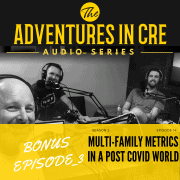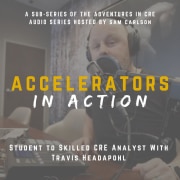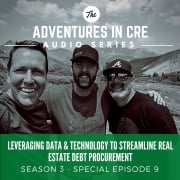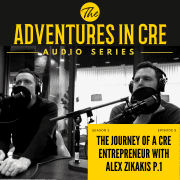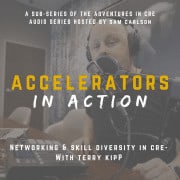Streamlining Commercial Real Estate Asset Management with Dottid | S3SP11
In this special episode of the A.CRE Audio Series, we feature Kyle Waldrep, founder of Dottid, and Senecca Miller, its CTO and COO. Dottid is a commercial real estate asset management optimization platform. It’s an operating tool for office, industrial, and retail owners across the country, as they manage, lease, and serve their tenants inside their portfolios. Their goal is to reduce inefficiency across teams and to enable tenants to be in spaces faster.
Commercial real estate professionals are often slow to adopt new technologies. People often think that since deals have been done like this forever, that’s the only way to get it done. Dottid recognizes that it’s time to stop thinking like this. In this conversation, Sam, Michael, Kyle, and Senecca talk about adopting new technologies in the real estate space and how they can streamline commercial real estate asset management.
Streamlining Commercial Real Estate Asset Management with Dottid
Or Listen to this Episode
Resources from this Episode
Episode Transcript
Announcer (00:01):
Welcome to the Adventures in CRE Audio Series. Join Michael Belasco and Spencer Burton as they pull back the curtain on everything commercial real estate, and introduce you to some of the top minds in the industry. If you want to take your skills to the next level and be part of a growing community of CRE professionals across the world, this is for you.
Sam Carlson (00:26):
Hello, and welcome back to the Adventures in CRE Audio Series. Today, we’re sticking in the theme of technology, efficiency, streamlining, and as chance would happen, we’re talking about asset management primarily. So we’ve got co-founders Kyle and Senecca on today with Dottid. Did I say that right, Dottid?
Kyle Waldrep (00:46):
Yeah.
Sam Carlson (00:49):
Well, cool. So instead of trying to say what it is y’all do, how you use innovation, technology to streamline asset management, I’ll turn over to you, Kyle, to give us a summary of what you do.
Kyle Waldrep (01:03):
Cool, Sam, thank you so much. Quickly, Dottid is really an asset management workflow platform. So if you’ve ever heard of Asana or Trello or monday.com, took a lot of the elements of workflow and product or project management-type software, so tasking and due dates and reminders, et cetera, stuff like that. And we really tried to make it as symmetrical with the asset management leasing process as we could. So, as I look at Dottid today, Dottid is really an operating tool for office and industrial retail owners across the country, as they seek to manage, lease, and ultimately serve their tenants inside their portfolios, hopefully reducing inefficiencies across teams and enabling more tenants to be in spaces faster.
Sam Carlson (01:49):
Wow. I know a bit about software technology myself, so I definitely see a need in… It’s funny because real estate is very traditional. All of these niches, whatever it is, they all function very traditionally. So you guys, you’re the younger generation, kind of look at it and say, well, I think there might be a little bit better way to approach this. What was the inception of Dottid? Why did you decide to do this in the first place?
Kyle Waldrep (02:18):
Yeah, so I’m the kid that got laughed out of the conference rooms and told that I was nuts. I’m that guy, my hand. But really the start of this was I was going to be in brokerage post-college, so I was going to lease CBD office space and obviously try and get tenants in nice, large buildings. And where I saw the inefficiency was around, you’ve got a multiparty, multi-month business transaction in lease, and you’ve got so many people, so much documentation and so much lack of process that really there was an opportunity to go build virtual process, hence now what Dottid has become, to surround that transaction cycle and enable the people to go do it as efficiently as possible. So a little bit of the inception, I actually turned down a job offer in a conference room at a brokerage house. I got laughed to the elevator, got down to the first floor, told my mom I’d turned my job down. That led to a fun conversation. And that same afternoon, cashed out my savings, moved home and got to work. Six years later, Dottid is the continuing fruition of that dream.
Michael Belasco (03:25):
So at that point, you’re laughed out of this conference room. You have little to no experience in commercial real estate, correct, at this point or…
Kyle Waldrep (03:34):
None. Zero.
Michael Belasco (03:35):
Zero. So what did you see from that first onset? What did you notice that said, hey, I can create an entire business around this?
Kyle Waldrep (03:46):
Sure. So to take a little bit of a step back from the job offer in the conference room, as you can imagine, there were meetings, coffees, lunches, et cetera, leading up to that during the interview process with a number of firms. And what I took that time to mean to me was really, I wanted to ask questions around what was wrong with someone’s job. It’s pretty easy to sell commercial real estate. You grind, you make it, you can make some good money. You can have a good life. That sells simple. [inaudible 00:04:16] that, I wanted to get underneath the surface of why did someone feel like something was inefficient in what they did for the 10, 8, 12 hours a day, whatever they worked? And thus, that’s how I went throughout the interview process.
Kyle Waldrep (04:31):
That also led to some really interesting interviews because people were very like, “Are you asking these questions?” But what I was trying to build was a narrative around, okay, great. If I’m going to be a junior leasing agent or a new analyst or whatever I was going to be, I wanted to do well. I’m not just in there for a job, I want to go make a name for myself. I want to go do it the right way and work hard and thus, I saw the opportunity and jumped for it.
Michael Belasco (04:58):
That’s amazing. This space, and I know this because of my past history at my previous company where I was CRO of this company and I was charged with optimizing, basically from closing to managing to selling, optimizing this process. And we realized there was such an opportunity here because where people traditionally think value is created, it’s in the deal making side. Real estate is so transactional that people neglect and a lot of the work gets pushed down from the more senior people to the more junior people. But there’s a lot of money and resources that are being wasted here, and you don’t really realize that when you’re 10,000 feet. And a lot of executives, their minds are up there. And so junior people coming in can see it.
Michael Belasco (05:49):
It’s so great to hear you talking about this because coming in at zero, having a team look, and we looked at everything, technology, how to templatize things, we looked for all these inefficiencies. But I had a team of experienced real estate professionals around me when we were doing this. And so it’s great that you noticed that so early. So then from there, I guess you recognized that, how did you see the value and then where did you go to start building this? Continue on, I guess. It’s fascinating to hear you recognize it so early on and see that there’s value that could be presented up to the more senior.
Kyle Waldrep (06:26):
Sure. You’re speaking to actually some of the things we now deal with on product perspective around… You’ve got so many different personas and types of users on the platform, and you have to be able to service them in a different manner. Leasing agents and engineer asset managers operate differently than obviously a COO or head of portfolio management. And thus that product can’t be just one direction, towards one set of users or personas. And that’s what Senecca, his team and the rest of our team have done so well is trying to create this place where you have a myriad of personas and users that are all able to do something well, to step back out of the product and back more into the timeline. Yeah. I went to Google. So I started reading. I was that kid who knew nothing and needed to learn something quickly.
Kyle Waldrep (07:14):
And so I was on page 106 of the Google tabs down below at the bottom of the search page. So if you’ve ever lived there, that’s where I was. And I was trying to pull firsthand documentation, any leases I could get my hands on, just let’s learn the terms and the lingo so that when I went into meetings with folks, as I was beginning to develop the conceptual nature of what the product should be, I didn’t sound stupid. I’m sure I sounded plenty stupid, but I didn’t want to sound all the way stupid. And so that’s really what happened for frankly, a couple of years, as I was writing out the plan for the business. Ended up coming up with an 80-page binded, labeled business plan summary, whole go-to-market strategy, whole pricing model. I actually drew out the first set of screens for the product on yellow legal pads.
Kyle Waldrep (08:06):
And I knew what I wanted, but then there’s this whole thing called capital that you have to go actually build a product. So to really fast forward the timeline, in summer of ’18, after a number of deals falling through and not coming to fruition, et cetera, we got the first round of funding done from six investors. And that funding was basically off a napkin. There was no screens, there was no product, there was no team. There was no anybody except me and my binder and yellow legal pads. And then what’s been really great as we look forward, Senecca has been the unbelievable technical back into me, where I can go speak out front and I tell Senecca, “Hey, we need to go do this.” And Senecca has been able to take his experience, his knowledge and his desire for digital transformation in this space and really make it come alive. So it’s been a really neat partnership.
Michael Belasco (09:05):
Excellent. So Senecca, you’re on this call, I’d love to hear how you guys met, what your primary function is in the space. And then we’ll get back in. There’s two pieces here. Well, there’s three. There’s this real estate piece, there’s this technology piece, and there’s this entrepreneurial piece to this whole story that I think is really fascinating. But Senecca, why don’t you just give us a little bit of a background. I’d love to hear more about [inaudible 00:09:32]
Senecca Miller (09:32):
I guess where the story kind of really picks up is at the time Dottid was being founded, basically, I had a managed services firm. And so the company was actually setting up its first kind of infrastructure. And so I, or my managed services firm at that time, actually set up the cloud for Dottid, just put their presence in AWS. It was a third party that was going to start developing. And so for us, it was just kind of like, hey, this is our starting point. We did a job and this third party’s going to come in and develop and we’re on our way. Kyle, at that point, kept making tracks and pushing the company forward. At that point, I wasn’t involved. I kept pushing the organization I was working with, ultimately sold that firm and then went back into the industry. I worked for a company called Varidesk, they’re now called Vari. They make standup desks and I was working on their global eCommerce platform. And from that-
Michael Belasco (10:28):
There’s one right there behind me.
Senecca Miller (10:29):
There you go. There’s tons of them in our office. We kept that part of the relationship. But yeah, I was working for them and then we rolled that out and ultimately at that point, landed at Toyota. I got a call from Kyle about a year or so into the Toyota journey, and he was like, “Hey, you want come over and work in commercial real estate?” And I was like, “Absolutely not. What’s there? There’s not any technology in this space.” And so we just kind of joked and laughed. And as he laid out just what the business and what the initiative was going to be, I sat back and I thought about it and said, wow, this is actually right up my wheelhouse. And so what I told him on that conversation, I just sat back and thought about it and said, “Hey, this is kind of an Uber and a Lyft inflection point.”
Senecca Miller (11:19):
If you really think about it, ride-sharing was there way before Uber and Lyft. You had them in the form of taxi cabs, right? You call back dispatch if your ride didn’t come. What they were able to do really is just create a platform and take out some of that inefficiency and put the power back into your hand. And as I thought about that, as he explained the process of how commercial lease transactions and things like that were done, I said, “This could be game-changing if we get it right.” And so signed up and jumped on board immediately.
Sam Carlson (11:48):
And if I might jump in here a little bit, I mean, that’s actually a very concise and articulate explanation of what… All of the podcasts, I think it’s been the last three or four, were all talking about how we’re using different technology stacks to streamline things, get rid of inefficiencies. And again, real estate is riddled with inefficiencies. It just it’s been done a certain way, person to person, paper, a lot of different things. I would like to understand a traditional asset management function, like what a company looks like without Dottid. And then I’d to see what it looks like with Dottid. What specifically, hours of the day, time, what are you doing? What kind of tangible things are happening differently with Dottid? So maybe if you could say the before state and the after state with Dottid.
Kyle Waldrep (12:46):
Hey, Senecca, I’ll handle the before and you handle the after.
Senecca Miller (12:48):
Go for it.
Kyle Waldrep (12:50):
So on the before state, I look at asset managers as the financial stewards of the asset that they are over. So obviously, asset managers, leading portfolio managers have a collection of assets, et cetera. And really their whole job is to make sure that the asset is ultimately performing well. To perform well, you need the space to be leased. That’s number one, that’s the basis of all cash flow in all real estate. If it’s not leased, it’s not making any money. Okay, great. So asset managers, communication and collaboration with their leasing teams, both internal and third party is crucial. So on a before state, typically that would be done through email and Excel, and you’d get periodic updates from leasing agents that hopefully are taking potential tenants on tours or hopefully are engaging the market to find tenants.
Kyle Waldrep (13:40):
But it also goes past that. It also is about, hey, when did we restripe our parking lines up front? When did we elevate the look of our lobby? What are the five-year capital expenditures that we need to be aware of? And again, that’s all been traditionally done, post-it notes, legal pads, emails, Excel, you name it, the very kind of archaic and manual processes. What Dottid is seeking to do and where Senecca will get to, is make that into a virtual location to get it all done.
Senecca Miller (14:10):
I think for the after state with Dottid, what that process really looks like, honestly, is being able to wake up and see exactly where everything lies in a single platform. The idea is when I wake up in the morning, I should be able to open up my laptop or open up my cell phone and basically see, hey, what’s the amount of space that I’m responsible for? How many deals have been moved? What tasks are still left on this deal to push it forward? I mean, the real idea is that we walk around with these kinds of mini-computers in our pocket and yet we are still placing phone calls and sending faxes and things of that nature. And the real question for me when I came into the industry was like, wow, this really doesn’t exist in a lot of other industries, the way that things are done in commercial real estate.
Senecca Miller (14:54):
I think my first question was, “Why are there so many people to get something done?” And so I always joke and tell people, coming into commercial real estate, I think I was just a little thrown off just by the sheer manpower that it took to get things done. And so what we look at and how we look at Dottid is that our job isn’t done until pretty much 100% of the process can be done within the platform. If you have to leave the platform for any portion of the deal, then we haven’t completed that life cycle for you. You should be able to take an inquiry right there because someone is interested in a space. You should be able to move that deal forward, convert that inquiry to a deal, and then basically have a set of tasks that you can actually run through to facilitate that lease.
Senecca Miller (15:39):
But the other piece of that is that it needs to be highly repeatable. There’s a human capital piece to bringing people on board, and by having templates and structures and things of that nature, you should be able to go and bring another person onboard and put them in Dottid and say, “Hey, this is the process on how we lease space in this particular building.” Here are our tasks. They should know 100% where they lie, in terms of the things they need to do to accomplish the lease and move the deal forward. But more importantly, everyone should have visibility as to where that deal stands. And so that’s really the end goal, is to bring what I would say, visibility to the deal in order to have people facilitate meaningful actions off of the information that’s on the platform.
Michael Belasco (16:22):
Awesome. It’s funny to hear you comment about… I’ve had this experience multiple times where new entrants into commercial real estate have the same response. Why is it done this way when there… And especially people coming from tech or heavy data backgrounds, they’re in a different industry and they come in and it feels archaic. I’ve seen it over and over again. I have firsthand experience. It sounds like one of the biggest pain points, I think, and I’ll sum it up in a word, is redundancy. Now, redundancy can be good and it can be bad. And in the context of it being bad, for example, you have assumptions or you have a data point and it has to be used in several different applications.
Michael Belasco (17:16):
Well, every time you got to go find that Excel file, you got to… My previous company, we had this, and I think it’s a common sentiment in other industries, sort of a single point of truth, where you enter something in and that auto flows. If I’m putting in something, I had notes with a prospective tenant, that potential comp, that tenant comp can then be permeated anywhere else I want to find that. What are some of your key tenets, I guess, basically, is really where I’m heading at that helps shape Dottid? What’s sort of a framework philosophy?
Senecca Miller (17:57):
Yeah. You want to take it? I think one of the things that has been big, and again, I’m a kind of storytelling person. So when you think about some of the things that are in the platform, one of the things that we focused on was approvals. There are so many times that a paper you’ve exchanged, different versions of a document, and now you’ve reached this final version, but this person may or may not know that it’s sitting in their inbox. And so when you think about that, one of the key things for us was first and foremost, we need push notifications. People need to be away from their systems, but still connected to what’s going on. That’s number one. Number two, we need to add in approvals. People need to know when a task is done, but if this needs another set of eyes on it, they can check that check box off and move to the next step.
Senecca Miller (18:45):
But then I think the biggest thing for us is, and Kyle touched on it, is touching on the personas. We try to really look at the different aspects of it. So for instance, in the platform, in our build stage, for instance, you can bring your building management or construction crew right to that process and get them involved. If I need a couple of things done in the space before I can move in, that persona can come right in, check those check boxes, upload files, and get approvals right there within Dottid to move that deal forward. So I think the biggest thing that we’ve added in addition to visibility, I would say, is probably the accountability within the platform.
Sam Carlson (19:19):
I’m looking right now at your website. And there’s a customer testimony that says, “In just 18 months, Dottid has increased our efficiency and enabled us to grow our portfolio by two and a half times while still continuing our high level of service.” So CRMs, you mentioned monday.com, these different platforms. The whole idea is as a project management streamlining tool, the whole idea is to remove redundancy. We talked about good and bad redundancy. But just to make it so the people can do more of the people things and the things that are repeatable can just happen automatically. In that specific example, do you know who I’m talking about by the way?
Kyle Waldrep (20:06):
I do.
Sam Carlson (20:07):
Joe?
Kyle Waldrep (20:08):
Joe Zylka.
Sam Carlson (20:09):
Yeah, so Joe Zylka. Maybe just using that as a case study, how did the behaviors of his company change before and after Dottid? We talked about before and after a little bit, but maybe even just use that as an example to illustrate what you guys are really doing for companies like his.
Kyle Waldrep (20:26):
Sure. So I’ll give you the history on Dogwood Commercial, which is where Joe’s a partner at, here in Dallas. So Dogwood started out buying assets, call it three or four years ago. They’re actually one of our first clients so they’ve seen us from infancy actually now to really an enterprise level product currently at the state we’re at. And as they were buying assets and putting assets on Dottid, they were obviously also hiring people to go manage and lease and property manage and do all the things. And so, one of the things that Joe and I frequently discussed was how do we do more with less people? Because more overhead is less money in everybody’s pockets, as familiar with everybody in real estate. And to your point, how do we start streamlining the basics to make sure that those basics are automatic and they’re not thought about?
Kyle Waldrep (21:15):
And so, as we continue to work with their team, their team was incredibly helpful in building out a lot of the major pieces of our product as they saw it. What we saw is they went from a few buildings to over three to four plus million square feet. And if you’re not having to add a broker, because you’re enabling your team through a technology platform to collaborate in a manner that is removing the friction to getting a deal done, then you have the ability to actually grow assets and portfolio size without having to grow overhead substantially. And that’s huge. And so that’s what it has tangibly looked like. I think they’re a really great test case on what engagement looks like. I really try and stay away from the word adoption. Adoption is so far overused in PropTech it’s kind of ridiculous. Everybody wants someone to adopt something.
Kyle Waldrep (22:10):
Commercial real estate people are slow to adoption holistically, because they’re in a lot of ways, slow to new change and to new tech. And thus, we look at how do you engage the platform? I love that Joe and his team and other customers are engaged in Dottid on a daily and weekly basis, but I don’t want them in there for hours a day. That means that they’re inefficient in terms of what we’ve built. We need them to be in there, get done what they need to get done, and get out so that they can go do either their deal-making, their property management, their asset management, et cetera, whatever their persona is. Get in, get done and leave, and allow Dottid to be that central location by which you’re ultimately reporting from and collaborating on as the center point.
Sam Carlson (22:56):
It’s interesting. I’ll interject one more time, Michael, and then I’ll let you wrap this up here. It’s interesting because my primary function within Adventures in CRE is marketing, advertising, digital marketing. That’s my background. And we talk to a lot of people in different parts of the space. And whenever we talked with development companies, I always want to know, okay, how long does it take you to lease out your building or your project, whatever it is? I want to know that. I’m like, well, what are you doing and how are you doing that? And every single time, I’m always met with the same types of answers, which is very traditional. It reminds me of just like, “Oh, we put flyers on people’s cars,” whatever, that kind of thing. And I’m just sitting here thinking, I’m like, oh, man, if these guys just knew the digital resources and what has been developed, just cloud-based, what has been developed to complete… I remember I saw when one guy, he’s like, “Oh, it takes us like three years to lease out this project.”
Sam Carlson (23:59):
I’m like, three years? And then I started thinking, and maybe Senecca, maybe you would think the same way, I started thinking, I wonder how many impressions they deliver to get that done. Because that’s all it is. How many impressions do you have to deliver on a piece of advertising to lease out a building? Okay. Well, can I deliver those impressions in 12 months instead? Yeah, I know how to, right? So it’s so funny. There’s so many of these things that, A, are traditional, and B, that people try to solve… It’s like you try and solve a problem based on a symptom. Okay? Well, if you just go upstream of the symptom, there’s a solution. So in that example, I’m like, you’re trying to lease out this space in an outdated way. What you’re really doing when you’re leasing out a space is you’re delivering impressions.
Sam Carlson (24:53):
Now, not all impressions are created equal. However, I can deliver you that volume of impressions in a fraction of the time. So let’s create a strategy around that. But that’s not the thought process that people are going through. They’re defaulting to the way it’s always been done. So I think companies like Dottid, like the companies that we’ve been talking to over the last several weeks, you’re really seeing, what we’re seeing is people having these epiphanies, saying, listen, it was done that way because we didn’t have this infrastructure, this automation that other people built for us. I mean, Senecca, I’m sure you’re building some of your tools, but you’re also just plugging things together that other people built. And so there’s the time to market, the efficiency to market, it is open and for the taking. I hope that if people are listening to this, a couple of epiphanies are happening.
Sam Carlson (25:52):
One, Dottid definitely is paving the way to efficiency in that space, so they probably deserve your attention. Two, it’s time to stop thinking, hey, deals have been done like this forever so that’s how they get done. Uh-uh. No, that’s not right. You should think upstream of your business and think, what’s happening? What’s been created today that I can take advantage of? The whole time we’re having this conversation, I’m just thinking of all these conversations we’ve had. I’m like, yeah, they don’t know about impressions. So it’s funny.
Michael Belasco (26:27):
The other major takeaway for me, and Senecca is that embodiment we just had mentioned, it is that you get locked into this is how it’s been done, this is how I’ve been taught. Granted, when you’re making a real estate transactional decision, whether it be a lease or a purchase, it’s a lot more permanent, it’s a lot more meaningful than whether you’re selling a product. However, what the incredible opportunity is, you bring to somebody like a Senecca, or even Kyle, who really didn’t have much serious experience, which is actually a benefit because you bring smart people into an industry that aren’t pre-programmed to think about the way it’s always been done, which to a lot of people it’s like, you want to learn from your mentors.
Michael Belasco (27:13):
You want to learn from the people who have done it successfully. Well, this is a totally new way of doing things. And you look at the trajectory of technology, it’s not new. You go back 20, 30 years ago. Commercial real estate’s taken so long that now it’s just the prime opportunity and it’s new in this space. So yeah, like you said, I’m very excited about Dottid and I look forward to… Actually, before we sign off here, I’d love to hear where you guys are planning to go next. What’s in store? What’s in the future for you guys?
Kyle Waldrep (27:50):
Senecca, I’ll take this out. So yeah, where we want to go is we want to go create our own category. We believe the technology in this space is lacking and we want to be the center point by which, and to Senecca’s point earlier, people in commercial estate, specifically in asset management and portfolio management wake up every day and they spend their day there. They need to know the information, the data, the tenants, the teams, the comments, et cetera, to go and enable what they do well to happen even faster.
Kyle Waldrep (28:22):
And so, as we look to the future, we’re spending a ton of time and a ton of resources to understand an asset manager or portfolio manager, leasing agents, day in, day out. And so that we are covering the breadth and depth of what they do in one place. That’s the future of where this industry goes. It doesn’t mean that we’re going to fully automate everything end to end, but it does mean that Dottid is building technology that will be symmetrical with how every operator, investment manager and pension fund ultimately does their business to enable their business to grow further. That’s what we want to do.
Sam Carlson (28:57):
Awesome. That’s a perfect way to sign off. Listeners, viewers, thanks for watching. And this has been a lot of fun. Dottid, you guys are definitely onto something. I checked out your website again while we were chatting here, see some awesome benefits, some awesome features. And so look forward to seeing what you guys do in the future. And to the listeners, watchers, we will see you on the next episode.
Announcer (29:22):
Thanks for tuning into this episode of the Adventures in CRE Audio Series. For show notes and additional resources, head over to www.adventuresincre.com/audioseries.
Frequently Asked Questions about Streamlining Commercial Real Estate Asset Management with Dottid

